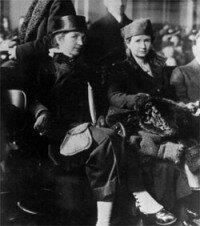Margaret (Higgins) Sanger was born on September 14, 1879, the sixth of 11 children, in Corning, New York. Her father was a poor Irish tombstone cutter. Her mother died at the age of 48 of tuberculosis. When she was 17, Margaret came to New York. She married William Sanger, an architect; joined the Socialist Party and nursed tenants in the tenements of Manhattan’s Lower East Side.
On a hot, muggy day in July, 1912, Nurse Sanger was called to attend Sadie Sachs, 28, a mother of three who was near death from attempting to abort another child on the way. Sadie begged Sanger and the doctor to tell her what she could do to prevent having more babies. The doctor told her to tell her husband to sleep on the roof. When Sadie Sachs died three months later of another self-induced abortion, Margaret Sanger felt it was time to crusade for birth control.
Margaret traveled to birth control clinics in France and Scotland in 1913. On her return to New York she began publishing a magazine called Woman Rebel with the motto: “No Gods, No Masters.” In this issue she forecast future articles on birth control. Postal inspectors confiscated copies and Sanger was indicted for sending birth control information through the mail. She fled to Europe to give herself time to prepare her defense. When she returned to the states, she discovered she was gaining public support in her efforts. There had been no actual writings in the first issue of her magazine regarding birth control. The indictment was withdrawn by the government.
But Sanger had not seen the last of trouble with the law. On October 16, 1916, she opened the first birth control clinic in the nation at 46 Amboy St. in Brooklyn. No fewer than 150 baby-buggy-pushing women from the Brownsville area lined up to pay a 10- cent registration fee. On October 25, policemen and, to her chagrin, a policewoman raided her clinic. Sanger was charged with distributing birth control information and was imprisoned for 30 days.
Sanger was not so tied up in her cause not to have suitors, such as writer H.G. Wells and pioneer sexologist Havelock Ellis. After her divorce in 1922 from her first husband, she married millionaire maker of Three-in-One oil (used mainly on sewing machines) J. Noah H. Slee, but only after he agreed to ensure her independence and allow her to use the name Margaret Sanger. They would also occupy separate apartments in the same building. The agreement shocked conventional minds of the ’20s, but the marriage held up.
The use of contraceptives remained illegal throughout the 1920s and ’30s. Though the use of them spread, few admitted to the “crime.” Sanger campaigned futilely for the mail to be opened to birth control information and devices. In 1937 the government finally gave in, but it was not until 1965 that Connecticut became the last state to allow birth control clinics.
That crusade at last successful, Sanger decided it was time to fight to secure the freedom of the individual woman. The female, in her terms, was: “a brood animal for the masculine civilizations of the world.” In the meantime, she became a role model for many women who wanted to control their own destinies and to achieve the goal of making every child a wanted child through birth control.
Margaret Sanger died in Tucson, Arizona on September 6, 1966.
by Vernon Parker (history@brooklyneagle.net), published online 09-14-2010 brooklyneagle
Для улучшения понимания см: The black community should ask why both the Democratic Party and black leaders oppose school vouchers and support abortion.
September 15, 2010
Subscribe to:
Post Comments (Atom)






No comments:
Post a Comment